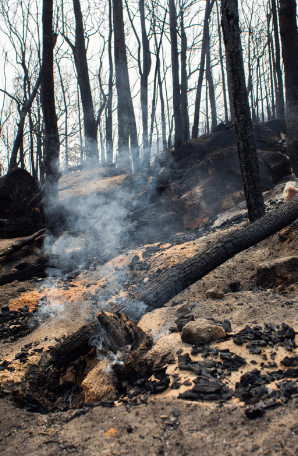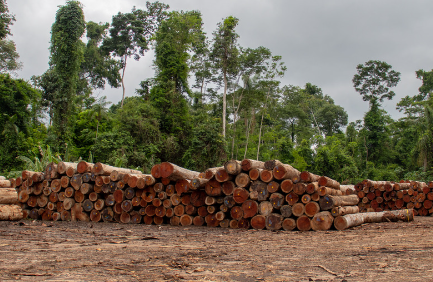Guidelines for salvage harvest, storage and processing of plantation-grown logs affected by fire
Lead Researcher: Dr Jim O'Hehir
The Project
As a consequence of the 2019/20 fires, Forest and Wood Products Australia Limited (FWPA) requested the development of guidelines for fire salvage and burnt log storage and processing for pine and eucalypt plantation-grown fibre in Australia.
Salvage of fire killed plantation timber requires addressing physical issues (e.g. degree of damage to standing trees, ability to harvest, management of burnt logs and processing of burnt logs) and financial issues (e.g. what is the best possible net financial position?). Following a fire, there is a need for rapid adaptation and innovation in response to emerging issues to maximise value recovery and response to unanticipated concerns, particularly relating to capacity to undertake work, and safety and environmental issues (this was a major learning from the salvage of softwood plantations burnt in the 1983 South Australian Ash Wednesday Fires). Decision making is influenced by market requirements, harvesting and processing capacity, fiduciary responsibilities and limitations placed on options by insurance and voluntary third-party certification. Environmental management issues run parallel to production issues (e.g. stabilisation of sites by over-sowing with grass).
Industry Partner
Sylva Systems Pty Ltd
Our Research Approach
As consequence of the impact of the 2019/2020 fires in Australia this project was designed to the develop guidelines for fire salvage and burnt log storage and processing, for pine and eucalypt plantation-grown.
Fires regularly affect plantation forest areas in Australia and every year various locations need to deal with the aftermath. Salvage of usable log products from burnt forest will always be a prime objective for the forest grower. In the case of fires that have a significant impact on future resource availability, effective salvage will also be a strong objective for processors.
A large amount of relevant Australian and international information and knowledge contributed by a number of foresters and mill personnel associated with previous major fire activities was brought together for this project.
The information has been collated, analysed and summarised into a single document to act as a set of guidelines for both growers and processors to reference when dealing with future significant fire events.
While the major focus in the report is on plantation timber, many of the findings are also applicable to management and salvage associated with native forests.

Key Findings
The final report, ‘Guidelines for salvage harvest, storage and processing of plantation-grown logs affected by fire’ includes an analysis of available data, identification of areas of future research requirements and recommendations for the development of an integrated fire management and response plan to inform both growers and processors.
While this report does not deal directly with the management of fire within the environment, it is important to ensure that fire control mechanisms form a significant part of integrated fire management and response plans. This includes the application of management processes that are capable of reducing fuel loads both within forest areas and on forest boundaries.
There are numerous examples of where prescribed burning practices that reduce fuel have either reduced or prevented the severe impact of fires. Most forest managers understand that strategic fuel reduction burns in native forest (and southern pine plantations) within Australia will either reduce intensity or increase suppression of wildfires.
What is the future of R&D in Salvage harvest, storage and processing of plantation-grown logs affected by fire
There are a number of priority issues that need to be assessed in regard to how the industry responds to fire events within current forest estates. These can be summarised into four key areas:
- Industry impacts associated with scale and probability of future fires.
- Salvage planning processes.
- Salvage operational processes including storage/stockpiling efficacy.
- Management of production processes associated with the variable fibre quality issues (physical and biological) relating to salvaged and stockpiled log products.



